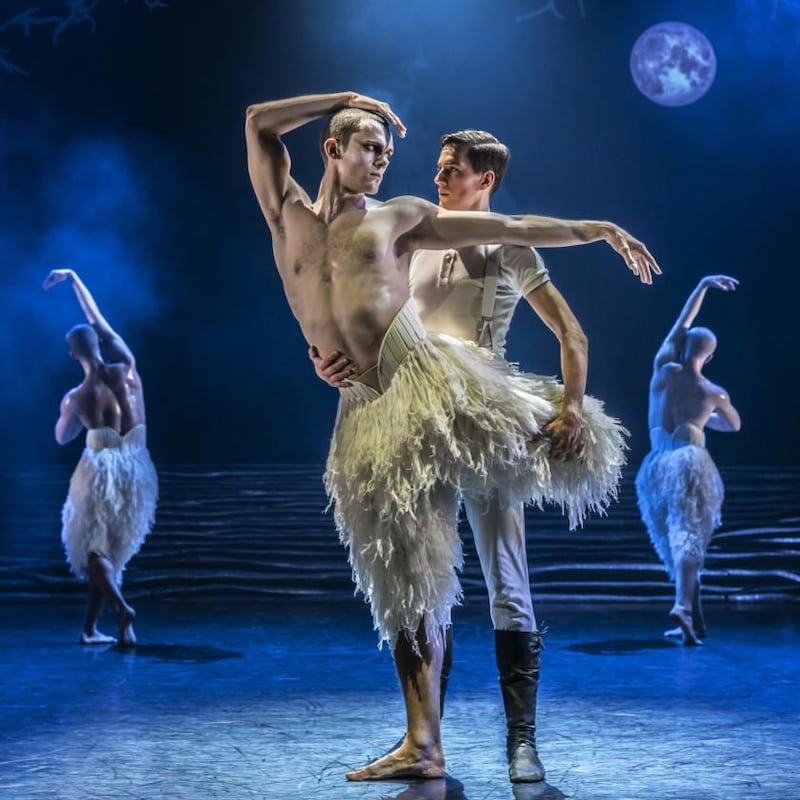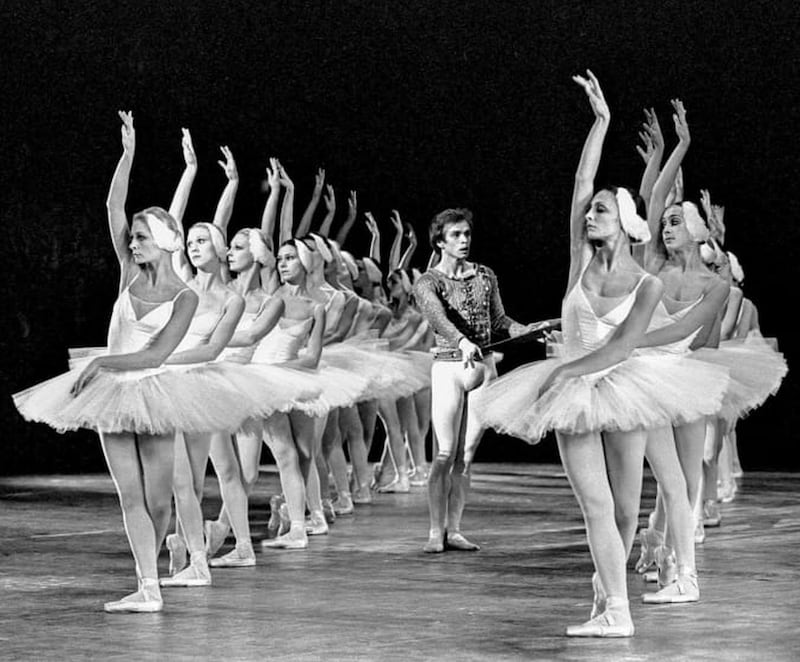With two touring companies, a British knighthood and a multimillion-pound arts organisation under his wing, the director and choreographer Matthew Bourne might easily dismiss a press meeting in favour of socialising with celebrity audience members. Johnny Depp and Cameron Mackintosh attend his shows, as do company patrons Darcey Bussell and David Walliams.
Yet Bourne arrives so nonchalantly for an interview to discuss his reimagined Swan Lake that someone else in the room mistakes him for an assistant. Laughing and settling into a booth at Manchester's Lowry Theatre, Bourne recounts some of the earliest shows he ever produced, where his audience members were somewhat less notable.
At the age of four or five I used to put on shows and invite people from down the street and charge them. I would say, 'Free cup of tea and biscuit with every ticket'
“From the age of four or five, I was always re-creating something,” Bourne says. “Back then I used to put on shows and invite people from down the street and charge them. I would say, ‘Free cup of tea and biscuit with every ticket,’ because it felt like part of what you did.”
His innate business acumen and exceptional talent have propelled his work on to stages worldwide since his Swan Lake first took dance-lovers by storm, in 1995. That show upended traditional ballet conventions so thoroughly by replacing the traditional flock of women with the now famous corps of feathered men that it earned three Tony Awards during its first Broadway run.
It also unleashed Bourne's talent, and since then he has acquired a dizzying array of honours during his nearly infallible career. Bourne not only has created full-length ballets for his own companies including Swan Lake, Sleeping Beauty, The Car Man and Romeo and Juliet (premiering later in 2019), but he also has choreographed for films such as Billy Elliott, collaborated with Mackintosh on Oliver!, and co-directed Mary Poppins in the West End. Despite his stream of accolades (seven Olivier awards, the British Inspiration Award and six honorary doctorates, to name only a few), Bourne appears to be happier backstage than in the spotlight.

"Having my name as part of the company name was never something I wanted to happen," he says. "The original name was Adventures in Motion Pictures and that became New Adventures. I purposefully chose a name that wasn't mine, but when we eventually did Swan Lake and started touring, the producer I was working with at the time said, 'There are so many Swan Lakes out there we have to explain in some way that it's different, so that we're not sort of fooling people into thinking they're seeing the classic.'"
Matthew Bourne's Swan Lake trades the traditional 19th-century prince, hunting for a swan, for a modern-day prince searching within himself. Abstract feathers replace traditional ballet tutus. Most notably, men take the lead swan roles in Bourne's version, which is why this Swan Lake has established itself as such a pivotal production for men in dance.
From the moment the curtain opens, Matthew Bourne's Swan Lake bursts with a lively and eclectic mix of dance theatre. Part West End musical, part neoclassical ballet, the combination has led to Bourne's reputation as a choreographer who respectfully straddles both worlds – with nods to cinema, opera, literature and current affairs.
In this production he presents a banquet of theatricality, starting with an oversized bed that becomes a stage on its own, climbed upon by a neurotic prince starved of his mother’s affection. Throw in a mechanical corgi and a blonde bombshell of a girlfriend and there’s enough to satisfy any ticket-buyer in the first act alone.

But Bourne boldly presents act two, one of ballet’s ultimate touchstones, as a showcase for male strength and grace. Instead of female swans emerging from the lake, a group of bare-chested men appears, channelling so much adrenaline it feels palpable. With silken feathers hanging from their chiselled waistlines, these men dance with such an intense, hypnotic energy, it has to be one of the most compelling dance scenes being performed today. And instead of stopping after a few sequences, it continues for an entire breathtaking act.
Other ballet choreographers have played with gender roles before. In 1982 British choreographer Ben Stevenson created his Cinderella for Houston Ballet and gave the stepmother and stepsister roles to men. Instead of pure pantomime, their parts involved a fair amount of dancing, which was unusual at the time. Mark Morris' 1991 Nutcracker spoof The Hard Nut includes a nearly equal number of men and women in its Waltz of the Snowflakes, so that men and women dance the same steps on pointe and in tutus, daintily flicking their wands and sprinkling their snow dust around the stage. Les Ballets Trockadero de Monte Carlo, who visited Dublin and Belfast last year, built their reputation on presenting all-male comedy ballet, putting men into pointe shoes way back in the 1970s.
Sometimes you'll go into a show with a new idea and afterwards he'll say, 'Scrap that.' So he's really honest. It's great because there are no boundaries
But Bourne's Swan Lake travels along another trajectory, presenting men in what have always been women's lead roles, this time with no comedy on which to fall back. In doing so, Bourne challenges some deeply embedded notions of beauty and strength.
His approach appeals to dancers as well as audiences.
"Early on in a production and throughout the tour, Matthew's always in the studio or theatre," says Liam Mower, one of the dancers who play the prince. "He's always encouraging us to develop our characters and the way we approach the production. He'll ask questions, give us some thoughts and ideas then ask us to try something different. Sometimes you'll go into a show with a new idea and afterwards he'll say, 'Scrap that.' So he's really honest as well. It's great because there are no boundaries. You can really go for it."
"The thing I look forward to most when I'm playing the queen is the end scene," says Katrina Lydon. "It's so hard because it's such a brief movement. The curtain comes down and you're left with all these feelings. It's over and you can't get them out, until you go out and take your bow."
Matthew Bourne's Swan Lake first came to Dublin in 2014, with its powerful ending that deviates from the Swan Lakes that have come before. Themes of love and betrayal connect his to the 1875 version for which Tchaikovsky wrote his score, but otherwise Bourne dispenses with tradition until the final curtain falls on a heart-wrenching tableau. The slightly reinvented production coming to Dublin this month takes the drama to another level with an even more intense finale. It's no wonder the cast have a hard time catching their breath when it's done.

Bourne manages to present such fervent drama without turning away classicists, while still attracting new audiences less familiar with dance. This crossover between dance and theatre has helped him to build a name for his company that defies categorisation. He even resists labelling the kind of background he requires when hiring new company members.
“Yes, ballet runs through the background of most dancers, even if they’re contemporary-trained,” Bourne says, “but my work is as much musical theatre as anything. Many of my dancers will proudly say they’re contemporary dancers. I just want good dancers, no matter where they trained.”
No matter how much he puts his own stamp on classical ballet stories, he still maintains a reverence for their origins. He hopes audiences will be as open-minded and curious coming to his shows as he was when he saw his first ballet.
“When I left school at 18 I didn’t really know about ballet. As a sort of self-education I decided to read things I hadn’t read and see things I hadn’t seen. I chose to go see a ballet and I remember thinking, Oh, that’s famous: I should go and see it.’”
The first ballet he ever attended was Swan Lake.
Matthew Bourne's Swan Lake runs from February 26th to March 2nd at the Bord Gáis Energy Theatre, in Dublin
After nearly 150 years, directors, choreographers and film-makers continue to reinterpret Swan Lake. What makes it so enduring?
The magnificent score anchors the ballet's place in history. Tchaikovsky first wrote the music in 1877 for the Bolshoi Ballet premiere in Moscow and at the time, remarkably, it met with only lukewarm success. In 1895 the Imperial Ballet in St Petersburg presented a slightly longer version, choreographed by Marius Petipa, which is the one most ballet companies reference today. That performance secured Swan Lake's place in the ballet canon.
What endures of the original choreography largely has been passed down from one dancer to the next, with artistic licence along the way. (No small amount of credit goes to Russian ballet master Nikolai Sergeyev, who is said to have smuggled some of Petipa's notations out of Russia in the 19th century.) Most commonly today, directors play with Swan Lake's ending. In some cases this involves death by the lake, and in others, a happy reunification between the swan and the prince.
No matter who remakes Swan Lake, they usually do so with gravitas, as the original choreography remains much revered. But as ballet has changed with the times, here are some of the more noteworthy Swan Lakes, in addition to Matthew Bourne's Swan Lake, that have since premiered.

- George Balanchine's Swan Lake opened in 1950 with New York City Ballet. In his usual fast-paced, syncopated style, Russian-born Balanchine put an American accent on Swan Lake with mercurial footwork, pared-down scenery and two acts instead of three. (New York City Ballet now has a three-act version in its repertoire, choreographed by Peter Martins in 2006.)
- Rudolf Nureyev presented his version in 1986 for the Paris Opera Ballet, when he was director of that company. No stranger to drama, Nureyev opted for an ending where the prince tragically dies.
- Frederick Ashton created a Swan Lake for the Royal Ballet that relied on Sergeyev's notes to honour Petipa's original. Ashton added some of his own character dancing, parts of which still remain in that company's version. The Royal Ballet's latest incarnation was restaged by Liam Scarlett and opened in 2018.
- Graeme Murphy took a risk in 2002 by making his Swan Lake more au courant for the Australian Ballet. He presents the main characters as present-day nobility and loosely references the love triangle between Prince Charles, Camilla Parker-Bowles and Princess Diana. Murphy also capitalises on Swan Lake's psychological elements by staging one scene in an asylum.
- Ditto Darren Aronofsky's 2010 film Black Swan, for which Natalie Portman won her Oscar. Aronofsky plays on the psychological link within the Odette/Odile role and uses this duality in some of the film's most captivating dance scenes.
- Most recently on European stages, the wunderkind Russian-American choreographer Alexei Ratmansky created a Swan Lake for Zurich Ballet and La Scala, again keeping true to the original. Ratmansky trained at the Bolshoi and now works with American Ballet Theatre, and Ratmansky's Swan Lake has been described as a deconstruction of the original, so painstakingly has he recreated the mood and overall feel of the Swan Lake from whence he came.





















